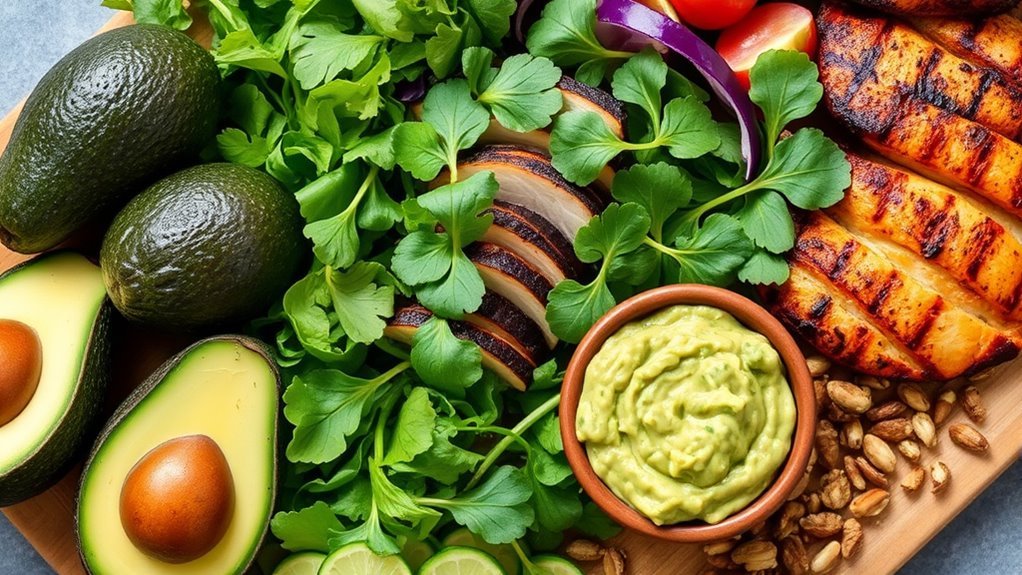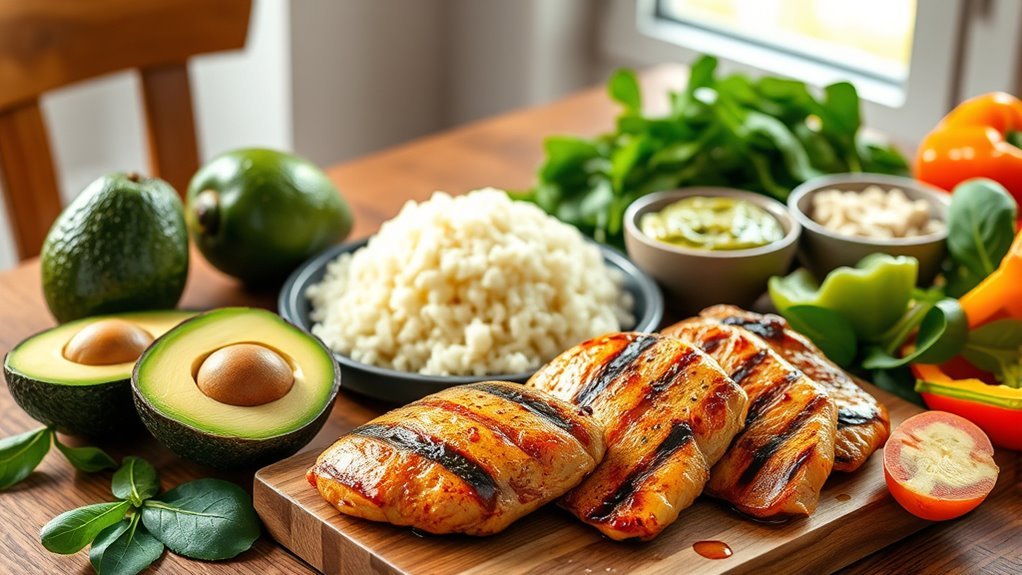The keto diet consists of a low-carb, high-fat eating plan. You’ll aim for about 70-75% fats, 20-25% protein, and only 5-10% carbohydrates. This shift helps your body enter ketosis, burning fat for energy instead of glucose. You’ll include foods like avocados, grass-fed meats, and non-starchy vegetables while avoiding high-carb items like bread and sugary snacks. It’s crucial to monitor nutrient intake to prevent deficiencies. Keep exploring to learn more about macronutrient balance and meal planning.
Understanding Ketosis: The Science Behind Keto

When you shift your diet toward a ketogenic approach, your body undergoes a remarkable transformation known as ketosis. This process initiates ketosis mechanisms that allow your body to switch from burning carbohydrates to burning fat for energy. As your carbohydrate intake decreases, your insulin levels drop, prompting your liver to convert fatty acids into ketones, which serve as a powerful fuel source. This metabolic adaptation not only helps in weight loss but also enhances mental clarity and energy levels. By embracing this state, you gain greater control over your hunger and cravings. Understanding these processes empowers you to make informed choices, embracing the freedom that comes from a well-functioning metabolism and a more efficient way of fueling your body.
Key Macronutrient Ratios in the Keto Diet

To successfully navigate the ketogenic diet, it’s important to understand the key macronutrient ratios that define this eating approach. Typically, you’ll aim for a macronutrient balance of about 70-75% fats, 20-25% protein, and only 5-10% carbohydrates. This specific ratio encourages your body to enter ketosis, which is where it burns fat for fuel instead of glucose. Monitoring your calorie intake is also vital, as exceeding your daily needs, even with the right macronutrients, can hinder your progress. By maintaining these ratios, you give your body the freedom to adapt to this fat-burning mode, enhancing energy levels and promoting weight loss. Remember, it’s all about finding the balance that works best for you within these guidelines.
Foods to Include in Your Keto Meal Plan

Incorporating the right foods into your keto meal plan is essential for maintaining ketosis and achieving your health goals. Focus on healthy fats like avocados, olive oil, and nuts to boost your energy. Include quality protein sources such as grass-fed meats, poultry, and fish to support muscle health. Don’t forget about low carb snacks—think cheese, hard-boiled eggs, or celery with nut butter, which can help curb cravings. Meal prep is a game changer, allowing you to plan and prepare balanced meals ahead of time, so you’re less likely to stray from your keto path. By choosing these foods, you’re setting yourself up for success while enjoying the freedom that comes with a well-structured diet.
Foods to Avoid on a Keto Diet
When you’re following a keto diet, it’s essential to steer clear of high-carb foods that can disrupt ketosis. This means avoiding sugary snacks and starchy vegetables, which can spike your blood sugar and hinder your progress. Understanding what to eliminate from your diet can help you stay on track and achieve your health goals.
High-Carb Foods
While you might be tempted to indulge in your favorite comfort foods, it’s crucial to recognize that high-carb foods can greatly hinder your progress on a keto diet. These foods can spike your blood sugar and kick you out of ketosis. To stay on track, avoid the following high-carb options:
- Bread and pasta: These staples are packed with carbs.
- High carb snacks: Chips and crackers may seem harmless but contain hidden sugars.
- Rice and grains: Even whole grains can disrupt your carb limits.
- High carb desserts: Cakes, cookies, and ice creams can derail your efforts.
Sugary Snacks
If you’re serious about maintaining ketosis, steering clear of sugary snacks is essential. Consuming these treats can spike your blood sugar and kick you out of ketosis, undermining your efforts. Instead of reaching for those candy bars or cookies, consider using sugar alternatives like erythritol or stevia. These substitutes can satisfy your sweet tooth without the carbs.
For snack replacements, try options like cheese crisps, nuts, or dark chocolate with a high cocoa content. These choices align better with your keto goals, providing flavor and satisfaction while keeping your carbohydrate intake low. Remember, it’s all about making informed decisions that fit within your lifestyle, allowing you the freedom to enjoy delicious snacks without compromising your health objectives.
Starchy Vegetables
Maintaining ketosis requires careful attention to your food choices, and starchy vegetables are among the foods to avoid. These veggies can spike your carb intake, making it harder to stay in ketosis. Instead, consider swapping them out for low carb substitutes. Here are some starchy vegetables you should steer clear of:
- Potatoes
- Corn
- Peas
- Carrots
Instead of these, you can explore starchy vegetable alternatives that are more keto-friendly, like zucchini, cauliflower, or leafy greens. By making these adjustments, you’ll not only maintain your ketosis but also enjoy a variety of delicious meals. Remember, embracing low carb substitutes is essential for your success on the keto diet, giving you the freedom to enjoy your food while staying on track.
Essential Nutrients to Consider
When following a keto diet, it’s vital to take into account the balance of macronutrients, as well as the vitamins and minerals your body needs. Adequate hydration also plays a key role in maintaining overall health and supporting your dietary goals. Understanding these essential nutrients can help you navigate the diet effectively and sustain your well-being.
Macronutrients Breakdown
Understanding the macronutrient breakdown is crucial for anyone considering the keto diet, as it directly influences your success and health outcomes. You’ll need to focus on the right macronutrient ratios to thrive. Here are key elements to remember:
- Fat Types: Prioritize healthy fats like avocados, olive oil, and nuts.
- Protein Sources: Choose lean meats, eggs, and dairy for adequate protein intake.
- Carb Sources: Limit carbs primarily to leafy greens and non-starchy vegetables.
- Meal Frequency: Consider how often you eat; some thrive on fewer meals with proper nutrient timing.
Don’t forget about calorie counting and necessary dietary adjustments to maintain your desired macronutrient ratios. This approach helps guarantee you’re fueling your body effectively while enjoying the freedom that the keto lifestyle offers.
Vitamins and Minerals
Incorporating vitamins and minerals into your keto diet is crucial for overall health and well-being. With the restriction of certain food groups, you need to pay special attention to vitamin sources and mineral absorption. Missing out on critical nutrients can lead to deficiencies.
Here’s a quick reference table to guide you:
| Vitamin/Mineral | Sources | Benefits |
|---|---|---|
| Magnesium | Nuts, seeds, leafy greens | Supports muscle and nerve function |
| Potassium | Avocados, spinach, mushrooms | Regulates fluid balance |
| Calcium | Cheese, low-carb greens | Strengthens bones |
| Vitamin D | Fatty fish, egg yolks | Enhances calcium absorption |
Hydration Importance
While the keto diet can be effective for weight loss, it also alters your body’s hydration needs, making it essential to prioritize fluid intake. Dehydration can hinder your progress and affect your overall well-being, so focus on maintaining your hydration sources. Here are key considerations for achieving ideal hydration and electrolyte balance:
- Drink plenty of water throughout the day.
- Include low-carb electrolyte drinks or supplements.
- Eat foods rich in potassium, magnesium, and sodium, like avocados and leafy greens.
- Monitor your body’s signals for thirst and fatigue.
Meal Planning and Preparation Tips
Meal planning and preparation can make or break your success on the keto diet, especially since it requires careful attention to macronutrient ratios. To simplify your journey, start with a solid grocery list and focus on meal prep that emphasizes portion control. Batch cooking can save you time and help you stick to your goals.
Here’s a quick reference table for meal planning:
| Meal Type | Snack Ideas | Recipe Swaps |
|---|---|---|
| Breakfast | Cheese and almonds | Cauliflower rice |
| Lunch | Guacamole and veggies | Zucchini noodles |
| Dinner | Salmon and spinach | Pork rinds crust |
Experiment with cooking techniques and consider meal timing for optimized energy. With these tips, you’ll enjoy the freedom of delicious, keto-friendly meals!
Common Mistakes to Avoid on Keto
Even with a solid meal plan, mistakes can easily derail your success on the keto diet. Understanding keto misconceptions and the common pitfalls can help you stay on track. Here are some mistakes to avoid:
- Neglecting electrolytes: Low-carb diets can lead to imbalances; verify you’re getting enough sodium, potassium, and magnesium.
- Overconsuming protein: While protein is essential, too much can kick you out of ketosis.
- Ignoring hidden carbs: Always read labels; sauces and dressings can contain sneaky sugars.
- Not tracking your macros: Keeping tabs on your carb intake helps prevent accidental overconsumption.
Potential Benefits and Risks of the Keto Diet
As you explore the keto diet, you’ll find it offers a range of potential benefits alongside some associated risks. Many people experience keto health benefits, such as weight loss, improved energy levels, and better mental clarity. These effects can result from reduced carbohydrate intake and increased fat utilization for fuel. However, it’s essential to be aware of keto diet risks, including nutrient deficiencies, digestive issues, and the possibility of developing heart problems if saturated fats are overconsumed. Additionally, some may encounter the “keto flu,” which can cause fatigue and irritability during the initial adjustment period. Balancing these benefits and risks is vital, so you can make an informed decision that aligns with your health goals and lifestyle.


